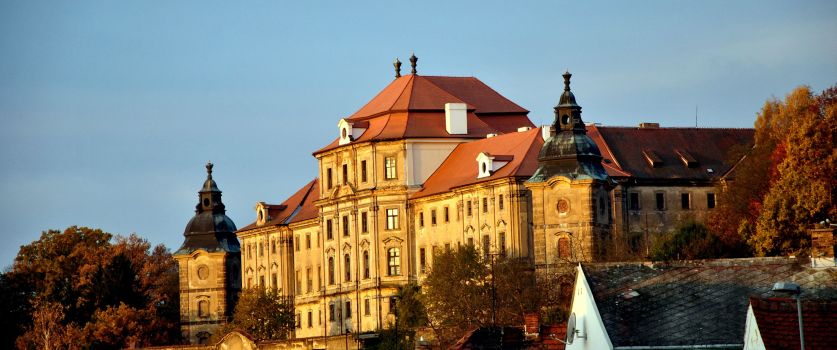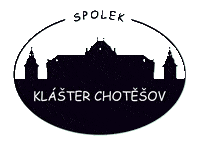The Nunnery of Chotěšov
The town of Chotěšov is situated 20 kilometres to the west of Plzeň on the main route from Plzeň to Domažlice. It is dominated by a Baroque convent with its adjoining buildings. This imposing complex can be seen both from the surroundings of the town of Dobřany and from the Plzeň - Klatovy road.
The nunnery of Chotěšov was founded in the years 1202-1220 by Blessed Hroznata, the founder of the monastery in Teplá, and the first order to be introduced in there was the women order of the Premonstratensians from Doksany. Hroznata´s sister Vojslava became the first patroness of the nunnery. Hroznata himself died a violent death in 1217. His sister Vojslava lived 10 years longer than him. During the Hussite wars, many nunneries and monasteries in West Bohemia were destroyed. The nunnery of Chotěšov was struck by this disaster in January 1421. In the course of the 15th century, when the convent recovered from the previous events, a house in the main square in Plzeň (today's Ethnographic Museum) was bought among other things. The time of the Thirty Year's War meant a reversal in the life of the nunnery. After Mansfeld invaded Plzeň in 1618, the provost of the nunnery was captured together with all the nuns and forced to hand over the convent treasure. The deserted nunnery was plundered then.
The Baroque convent was given its present appearance in the years 1737-1756 by the architect Jacob Auguston Jr. On September 2, 1750, nuns were ceremoniously introduced into the new building of the convent. However, the new life in the convent did not last long. As many other nunneries, monasteries and churches, the nunnery of Chotěšov was abolished in the reign of Josef II, on January 21, 1782. Its property passed to the newly established religious fund. In January 1822, the Chotěšov dominion was bought by prince Karl Alexander Thurn - Taxis from Regensburg for 1,080,000 gold coins. In 1878 the convent building was rented out to the nuns of the order of the Visitation of Our Lady (salesians), banished from Moselweiss by Koblenz in the Rhineland. They founded a renowned boarding school in Chotěšov, which was attended by girls, who studied mainly foreign languages there. The activities of this institute were interrupted by the war events in 1939. During World War II the nuns took charge of the old women's home established in the convent. One of the wings of the convent was occupied by 200 German girls working in the surrounding ammunition factories. After 1945 the resettlement of German inhabitants from Czechoslovakia started, and so the nuns of German nationality had to leave the convent, too. Only about 30 Czech nuns remained and kept the old women's home working.
A further disaster followed in 1950, when the nuns were evicted and the Czechoslovak People's Army moved into the (then still beautiful) Baroque nunnery. This moment started the process of the devastation of cultural values, which at that time hardly anybody allowed to enter his/her head. Among others, the singer Karel Kryl spent part of his military service there. The Army left the buildings in the years 1973 - 1975. The damage caused by its stay amounted to 10 million crowns, a sum which has never been compensated. The nunnery had remained empty since then and was administrated by "Výpočetní a kontrolní ústředna spojů Praha" (the Central Office of Communication in Prague) and later by "Státní ústav památkové péče a ochrany přírody v Plzni" (the National Trust in Plzeň). In 1991 the ownership of a part of the nunnery passed to the town of Chotěšov (the prelature and the outbuildings), the larger part (the convent, the pavilion and the gardens) fell to the order of the nuns of the Visitation of Our Lady in Chlumec.
Today, the order property is administrated by the town of Chotěšov. After the Nunnery Foundation had been abolished in January 1998, a civil association providing guide, research and promotional services for the nunnery came into existence. Two concerts held in the convent in 1997 and 1998 are evidence of the activity of this association. It is also possible to visit an exhibition in the convent and Gothic cellar rooms under the building of the prelature.
The biggest activity carried out in the convent nowadays is the effort to re-deck a large fresco (180 metres square) by Julius Lux. The painting is situated over the main staircase of the convent and it had been removed at the beginning of the 1990´s. The association is also busy with the repair of the roof over the chapter hall and the church. The town hall and the members of the civil association hope to be successful in saving this Chotěšov landmark and preserving it for next generations. The whole income from admission fees, gifts, rentals and appropriations is being used for the repairs of the buildings. The main aim, however, is to find a way of utilization of the whole complex and save it this way.
You can translate whole site with Google Translator
An article The life of Hroznata, founder of the Monasteries of Teplá and Chotěšov
© Spolek Klášter Chotěšov 2012 - 2023
Plzeňská 88, 33214 Chotěšov


